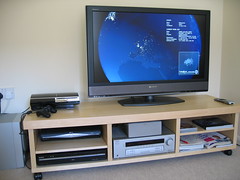Many Canadians are more than familiar with “funded in part by a grant from the Canadian Film and Tax Fund” tagged at the end of most Canadian-made productions. This fund was setup by the federal Canadian government many years ago, to ensure Canadian broadcasters had an incentive to produce their own Canadian-grown content, rather than relying solely on American-made productions.
Recently, the federal government decided to change where that money comes from, and as is typical of governments looking for more money, they imple
 Image by William Hook via Flickr
Image by William Hook via Flickr
The federal government passed this tax onto the cable and satellite providers, as a fee equal to about $10 per subscriber. Naturally, the cable and satellite providers have passed this new tax onto their subscribers. And this is where the battle cries began.
In tough economic times as we’ve been in, we’re all trying to save money. And for most of us, if that means cutting back on our entertainment expenses, say cancelling some of the channels we don’t watch to save a handful of dollars, for the most part we’ll do just that.
Research has shown that for every price increase in cable and satellite services, over 40 percent of those subscribers will adjust their subscriptions to counter the increased fee. According to the same study, about five percent of cable television subscribers hit
 Image by Mark Blevis via Flickr
Image by Mark Blevis via Flickr
So, just ahead of the addition of this new tax on their customer’s bills, the cable and satellite companies informed their customers of the new fee, and in a not quite objective letter, blamed the local broadcasters for the cash grab. They even included contact information so their customers could complain directly to their local federal Members of Parliament (MPs) – how nice of them.
The local television stations retaliated claiming they would go off the air, if they didn’t have this funding to produce quality, Canadian programming. Their news crews did “investigative” pieces on how the money is used, and what will happen if the government seed money stops coming. They ran – and continue to run – ads saying they will go out of business if they don’t get the money to produce Canadian content.
The cable and satellite companies continued the battle, with their own ads, more letters and emails to their customers, and claims that Canada’s private broadcasters made a combined total of over $4 billion in profits – hardly penny-poor in need of a handout.

Although these very same service providers aren’t exactly desperate for cash either, making mega-huge profits off their subscribers. One of the biggest cable companies in Canada – Rogers Cable -- has made so much over the years, they have bought professional sports teams and stadiums. Currently, Rogers owns Major League Baseball’s Toronto Blue Jays, and their home stadium, formerly “The SkyDome,” renaming it “The Rogers Centre.”
SO what is the truth in amidst all this propaganda from the local Canadian private broadcasters, and the cable and satellite companies?
The truth is the federal government continues to demand Canadian content produced and aired by our local broadcasters, but has decided they just don’t want to fund it anymore. So they mandated – through the Canadian Radio and Television Commission (CRTC) that all television service providers pay this fee, else they would block the signals of the major American networks – ABC, CBS, NBC, and FOX.
This whole war started because some select members of our federal government were looking for a new revenue stream and they realized the government had been subsidizing Canadian content for years. Back in the mid to late 1990’s, they changed the rules governing local Canadian channels and television service providers.
They began retooling the Canadian Film and Television Tax Credit, and a
 Image via Wikipedia
Image via Wikipedia
As more diverse as the television dial became, the government realized it was impossible for the television service providers to cater to the many needs of their subscribers with one channel, and they removed that mandate for a local community channel from the rule book – with some lobbying from the television providers themselves – naturally.
This unfortunately also opened up the possibility, to the federal government, that they no longer needed to pump as much money into funding local Canadian content. But they always put pressure on the television broadcasters to continue to create this home-made content.
And rather than face the wrath of the Canadian population as a whole, for cutting this subsidized funding for Canadian-made productions, they decided it would be an easier political pill to swallow for the television service providers. They never thought for a second, that the television service providers would in turn, pass this new tax onto their customers – though that just makes sense.
And now we have a war of words being aired very publicly on televisions across the country, as the big cable and satellite companies go head-to-head fighting for what each believes is in their best interests.
While us lone consumers who subscribe to these services are stuck in the middle of it all – all while watching are cable and satellite bills increase.
What should be done, is to go back to the original model, where television service providers, local private broadcasters, and the federal government each contribute a fair share of money to a fund for local, Canadian content – without charging anything directly back to us subscribers.
This was how it was for much of the 1970’s until the late 1990’s, when the federal government introduced laws to deregulate the cable and satellite industry. They had hoped that these changes would open the market, which in turn would lower the cost for subscribers via good old fashioned competition.
That plan fell through the ice like a barrel full of bricks, as many of the smaller, local cable companies were bought up and swallowed by the already mega-large cable and satellite providers.
And now it has come full circle, as the government’s plans to increase competition have failed, but they continue to act as if they were successful, by implementing this new tax. But because deregulation has failed, there isn’t a broader, more competitive customer-base to draw additional funds from.
Yet the government – never all that quick on the uptake – is still bargin
 Image via Wikipedia
Image via Wikipedia
And we haven’t even scratched the surface when we toss the end of analogue signals into the mix. This year, American stations stopped broadcasting on what was called “over-the-air” via the good old fashioned Ultra High Frequency (UHF) band. Remember when you were able to just plug in a TV anywhere there was an electrical outlet, and watch fuzzy stations using “rabbit ears?”
Not anymore in the States – and soon not anymore in Canada either. As digital signals, with their high definition digitally crisp and clear pictures dominate the landscapes, both Canadian and American federal governments have decided to acquire those UHF frequencies used by television broadcasters for emergency signals and lower-band cell phones. So if you don’t already subscribe to cable, eventually you will have too – otherwise all you will see on your TV is your own reflection.
Maybe we all should write our local MPs and tell them to wake up, look around, and work with what is, rather than what they thought would have been?
![Reblog this post [with Zemanta]](http://img.zemanta.com/reblog_b.png?x-id=afdcce91-53ab-4582-8122-97fab5afad3e)








No comments:
Post a Comment